This week has seen a continuation of the upward trend in the Netanyahu bloc, as the predictable effects of the breakup of the Joint List, a mostly Arab Alliance, were felt.
That bloc — Likud and the other parties allied with opposition leader Benjamin Netanyahu — picked up 1.2 seats in our average over the course of the week, increasing to 60.6 seats – the biggest weekly change since the campaign began.
Following on from last week’s article about the impact of different polling companies, we should note that of the nine polls taken this week, the Netanyahu bloc hit 61 or more in only three of them – two from Direct Polls.
In the seven polls taken by other companies, the bloc averaged 60.1, and only got to 61 once.
In light of this trend, we will use this article to analyze the state of the election from the perspective of Prime Minister Yair Lapid.
Get The Times of Israel's Daily Edition by email and never miss our top stories
We’ll look at the rationale behind his hotly debated UN General Assembly speech on Thursday, how he may look to close out his campaign, and most importantly, the crucial dilemma he faces that could possibly determine the election.
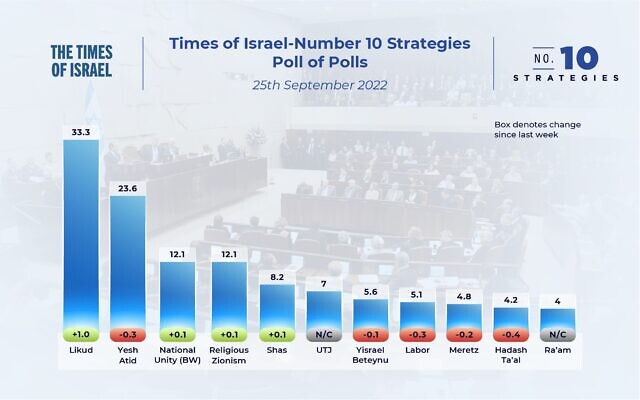
The state of the Israeli election campaign: Poll of polls, September 25, 2022, showing the number of seats parties would be expected to win if the election was held today, based on a weighing of the latest opinion polls.
The Zionist anti-Bibi bloc
While Lapid is not the only potential prime ministerial candidate among the anti-Netanyahu parties, he is the uncontested leader of the “anti-Bibi” bloc.
The bloc itself is extremely ideologically diverse, spanning from Meretz on the left to Gideon Saar’s faction of the National Unity party on the center-right. It is even more diverse if you include the Arab Ra’am party, and even Hadash-Ta’al, but for the purposes of this article we will focus on the Zionist parties in the bloc.
Over the past five cycles, the bloc of those parties has hovered at around the 50-seat mark, and it is currently polling at an average of 51.2, right in the middle of where it has been for the past few years. It is worth noting, however, that with seats for Arab parties currently at an all-time low (8.2 as things stand, as opposed to 10, 15 and 13 in the past three elections), one might have expected the anti-Bibi bloc to be slightly higher, as there are more seats to go round for the remaining parties.
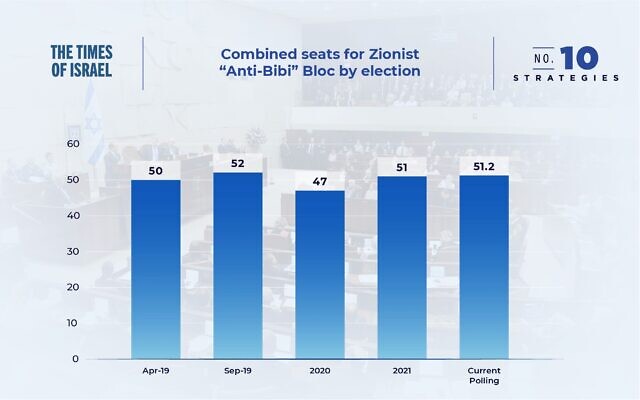
Combined seats for Zionist “Anti-Bibi” bloc by election
Nonetheless, the main takeaway from these figures is that the anti-Bibi bloc is unlikely to grow much beyond its current 51.2 seats, meaning that if Lapid’s Yesh Atid wants to grow its share, that will likely have to come at the expense of other parties inside the bloc.
From a unipolar to a multipolar bloc – and back again?
While the overall vote share of the anti-Bibi bloc has remained fairly consistent for the past five cycles, its structural makeup has changed significantly.
In the first three recent election cycles, in 2019 and 2020, the bloc was dominated by one large party (the Blue and White alliance led by Benny Gantz and Lapid) who controlled around two-thirds of the bloc, with two or three much smaller parties effectively playing the role of “satellites.”
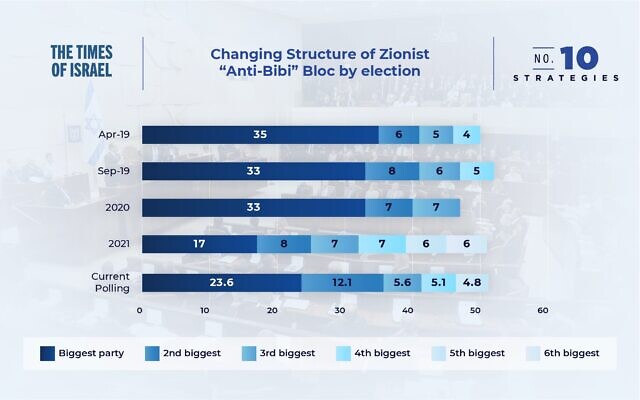
The changing structure of the Zionist “Anti-Bibi” bloc by election
The breakup of Blue and White in 2020 changed this dynamic. At the 2021 election, Lapid’s Yesh Atid “inherited” around 50% of the party (17 seats out of a previous 33), but Gantz’s Blue and White only won eight. The remaining eight seats migrated to the record four smaller parties in the bloc. Yesh Atid was clearly the biggest party in the bloc, but it only controlled one-third of the bloc’s 51 seats.
This was not out of any failure on the part of Lapid. In fact, he ran an exceptionally disciplined and strategically savvy campaign. Aware that he was a divisive figure (much more so than Gantz), he made the calculation that the best way to grow the bloc was not to go after former Blue and White voters directly, but rather to allow them to move freely to whichever smaller party in the bloc they felt most comfortable with. Indeed, this strategic savvy laid the foundations for the formation of the Bennett-Lapid government.
What now for Lapid?
The question, though, is what this means for Lapid today? As the incumbent prime minister, maintaining a low profile and working solely for the betterment of the bloc as a whole is no longer an option.
In order to enhance his own standing, he will want to close the gap to Likud significantly. Equally – if not more – importantly, he would hope to increase the gap between Yesh Atid and Gantz’s National Unity party, so as to ensure that he is the bloc’s sole prime ministerial candidate.
Ultimately, he would love to replicate the unipolar structure of the bloc, pushing Yesh Atid up towards 30 seats. The question is how?
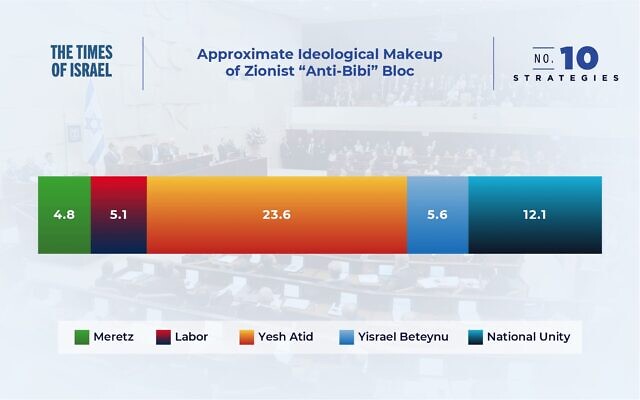
The approximate ideological makeup of the Zionist “Anti-Bibi” Bloc
Looking left, Lapid sees around 10 seats, at least two to three of which should be there for the taking. Dating back to Tzipi Livni in 2009, leaders of the center-left bloc have generally been able to siphon off votes from the left by positioning themselves as the only alternative prime minister to Netanyahu.
The problem for Lapid is that neither Labor nor Meretz are polling much above the 3.25% electoral threshold. Therefore, an aggressive campaign aimed at more centrist Labor voters (a natural target) could well end up pushing Labor under the threshold. That is exactly why he was so eager for Labor and Meretz to merge, as it would have given him the freedom to compete with them risk-free for votes. Their failure to do so limits his options.

National Unity party head Benny Gantz launches his party’s campaign for the upcoming elections, September 6, 2022. (Tomer Neuberg/Flash90)
To the right of Yesh Atid, the situation is slightly different, but equally challenging. The problem here is that voters on the right of his bloc, according to the data, traditionally like him less than they do Defense Minister Gantz. And while he would love to weaken Gantz, he will have to be very careful in competing with him for these voters – who are naturally more predisposed to a more center-right message. Furthermore, in competing for them, he runs the risk of losing some of his own left-leaning voters to Labor.
Lapid’s predicament regarding Yisrael Beytenu voters is similar to that regarding Labor voters. While the bulk of Avigdor Liberman’s voters (older, Russian-speakers) are fairly loyal to him, Lapid could definitely compete on the fringe, notably on issues of religion and state. However, as with Labor, the risk of driving Yisrael Beytenu under the threshold far outweighs any potential benefit.
A mobilization strategy
All of which means that when Lapid surveys the political landscape, he sees plenty of challenges and not too many solutions.
Ideally of course, he would take one seat from of each of the other parties in the bloc – enough to boost his vote, but not so much as to push them under the threshold. But politics is not precise, and there are often unintended consequences. Even a subtle, calculated outreach to Labor or Yisrael Beytenu voters could be too effective, with disastrous results.
So in the end, the logical best path for Lapid looks like being one of mobilization rather than persuasion.
In practice, this means that rather than trying to persuade voters to Yesh Atid’s immediate right or left to switch to his party, Lapid would look to increase turnout among those who think and act like his existing supporters, but are currently apathetic or unmotivated to vote.
Consequently, we should expect big GOTV (get out the vote) campaigns aimed at achieving differential turnout in areas such as Hod Hasharon, Herzliya, Kfar Saba and Givatayim, all of which voted between 26 and 30 per cent for Yesh Atid in 2021, but where around one-third of eligible voters did not vote. Such a strategy also plays to Yesh Atid’s strengths, namely its traditionally well-managed, and maybe even unrivaled, field operation.
Understanding Lapid’s speech
This approach, we believe, helps explain a large part of the political rationale behind Lapid’s mention of the two-state solution and a Palestinian state in his speech Thursday at the UN General Assembly. (There were ideological and diplomatic reasons for it too, no doubt – but for the purpose of this column, we must focus on the politics.)
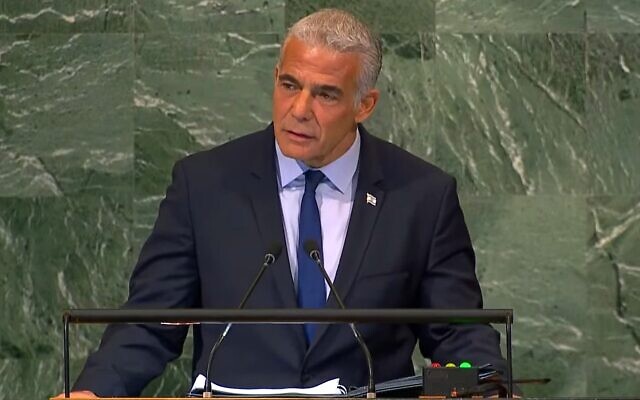
Prime Minister Yair Lapid addresses the United Nations General Assembly on September 22, 2022. (YouTube screenshot, used in accordance with Clause 27a of the Copyright Law)
While Lapid’s focus on a two-state vision has generally been seen as a tack to the left and an attempt to “cannibalize” Labor and Meretz voters, this seems like an extremely risky strategy considering the aforementioned proximity of those parties to the threshold.
It seems unlikely that a candidate so strategically sound in the last election would adopt such a dangerous approach this time that risks handing the election to Netanyahu on a plate.
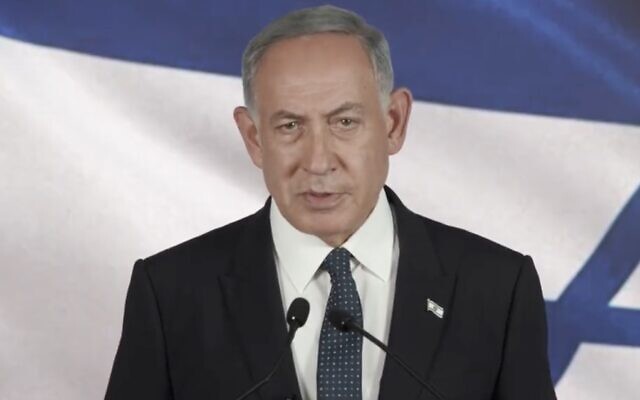
Opposition leader Benjamin Netanyahu criticizes Prime Minister Yair Lapid for endorsing the two-state solution at the UN General Assembly, in a video statement released on September 22, 2022. (Twitter screenshot, used in accordance with Clause 27a of the Copyright Law)
We therefore would see Lapid’s high-profile mention of the two-state solution as part of this mobilization strategy — an attempt to increase both enthusiasm and hope within the bloc, leading to increased differential turnout.
In short, it marks an attempt to give hesitant or non-voting centrists (or those who should be centrists) a reason to go to the polls.
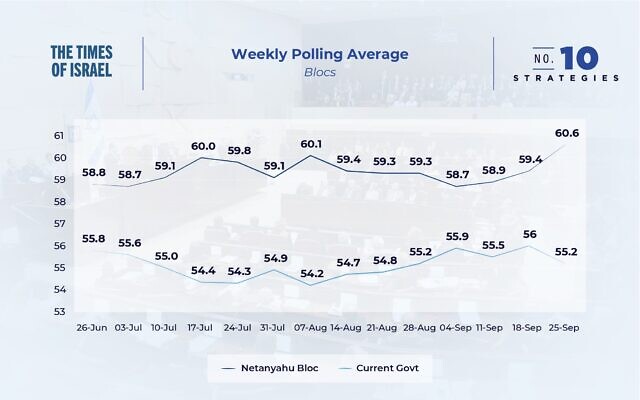
Weekly polling average of the rival blocs
Whether this will be enough to make a difference is debatable.
Getting non-voters to the polls is easier said than done – especially after four elections in quick succession. And the risks of cannibalizing Labor (and to a lesser extent, Meretz) voters, and thereby pushing them under the threshold, are very real.
But with very little strategic room to maneuver, it looks like Lapid sees it as his best bet.
—
* Full disclosure: The authors of this piece have recently conducted polling on behalf of Meretz.
Simon Davies and Joshua Hantman are partners at Number 10 Strategies, an international strategic, research and communications consultancy, who have polled and run campaigns for presidents, prime ministers, political parties and major corporations across dozens of countries in four continents.


